p.968
p.974
p.978
p.983
p.989
p.993
p.998
p.1002
p.1007
Research on Voltage Stability in Grid-Connected Large Wind Farms
Abstract:
Squirrel-cage induction generator (SCIG) has been widely utilized in large wind farms in China. However, the large wind farm composed of induction generators will cause obvious power system stability problems due to the dependency on reactive power. Doubly-fed induction generator (DFIG) has excellent dynamic characteristics of wind farm operations. With the increasing of wind power penetration in power systems, more and more wind farms use both SCIG and DFIG. This paper firstly analyzes the the dynamic characteristic of wind farm on power systems, especially in terms of the voltage stability. Then the interaction between the SCIGs and DFIGs is also investigated. A detailed simulation model of wind farms is presented by means of MATLAB. The simulation results demonstrate that the DFIG applications will improve the voltage stability of the wind farm largely and the low voltage ride through characteristics of SCIG to some extend.
Info:
Periodical:
Pages:
989-992
Citation:
Online since:
October 2011
Authors:
Price:
Сopyright:
© 2012 Trans Tech Publications Ltd. All Rights Reserved
Share:
Citation:


